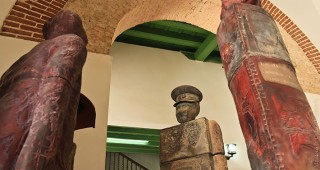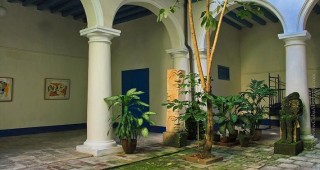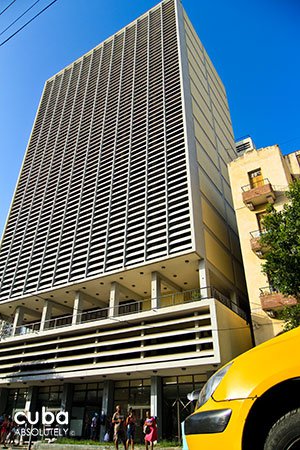In 1953, architect Antonio Quintana won the competition for the design of a building which would house doctors’ offices, stores and other public spaces. The use of brise-soleil, popularized by the French architect Le Corbusier and readily assimilated by Cuban architects and from other countries in the Americas, especially, Brazil, given its practical applicability in tropical climates for both shading and ventilation purposes, is an outstanding feature of this building. The brise-soleil here also offers an aesthetically pleasing appearance, which some experts claim was influenced by the skyscraper project designed by Le Corbusier for Algiers. The vestibule features El dolor humano, a mural painting by the Cuban painter Mariano Rodríguez. Today, the building is home to the Faculty of Economics of the University of Havana, as well as the Talía Theatre and the L Art Gallery, the latter two on the ground floor. The building was awarded Gold Medal by the National School of Architects in 1956.

Museo Nacional de la Cerámica Contemporánea Cubana (Casa de Francisco Aguilera Basabe) LH  2
2
Housed within Casa de Francisco Aguilera Basabe, a two-story building built in 1728, this museum exhibits Cuban art pottery from 1950 to the present day on the top floor, while the ground floor has a …
 ColonialAdmission: FreeOpen: 9am-5pm Tues-SunMercaderes esq. a Amargura, Habana Vieja
ColonialAdmission: FreeOpen: 9am-5pm Tues-SunMercaderes esq. a Amargura, Habana Vieja 
Cementerio de Espada LH  2
2
First called Cementerio General de La Habana, the Cementerio de Espada was built after the Spanish authorities issued a Royal Edict banning burials in temples because it was considered unhygienic. The …

Fuente de Neptuno LH  2
2
The Fuente de Neptuno (Fountain of Neptune) was imported from Italy. Besides its ornamental function, it also supplied water to three boats at the same time, for which large iron rings were placed for …

Avenida de Carlos III (Ave. Salvador Allende) LH  2
2
This street was built by order of Governor Miguel de Tacón in 1836 and connects the intersection of Reina and Belascoaín streets to the Castillo del Príncipe. It was originally named Paseo de Tacón. L …

Casa Oswaldo Guayasamín LH  2
2
This institution honors Ecuadorian painter Oswaldo Guayasamín (1919-1999), a dedicated socialist, supporter of the Cuban Revolution, and close friend to Fidel Castro. It’s located in an 18th-century m …

Casa Cubana del Perfume LH  2
2
This quaint and lovely shop sells perfumes from the Cuban Suchel brand, and prepares personalized fragrances on site according to patrons’ tastes. It also doubles as a small museum, with a 19th-centur …

Parque Arqueológico de la Maestranza LH  2
2
By the 1700s, Havana boasted an artillery factory for the manufacture and repair of weapons and ammunition. The factory was demolished and a “castle” was the built for the Police. This archeological s …

Hotel Presidente LH  2
2
This is Havana’s first skyscraper and was inaugurated on December 28, 1928. It took its name from the street it is situated in and is the only hotel that features Cuba’s coat of arms on its façade. It …
 ModernROOMS: 158Calzada #110 esquina a G (Avenida de los Presidentes)
ModernROOMS: 158Calzada #110 esquina a G (Avenida de los Presidentes) 
Clock Tower LH  2
2
Between 1921 and 1924, a clock tower was built on Fifth Avenue. It was designed by New Yorker John H. Duncan, one of the architects that contributed to the layout of the avenue and who also designed t …

Museo del Naipe Marqués de Prado Ameno LH  2
2
Opened on May 2, 2001, the small yet immensely impressive Playing Card Museum occupies the ground floor of the Casa del Marqués de Prado Amero, dating from the 17th century and the oldest building in …





